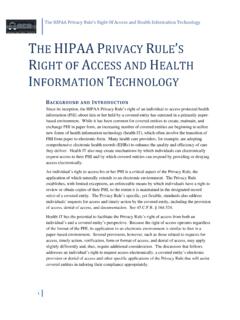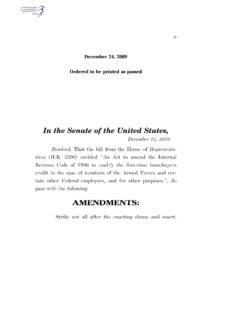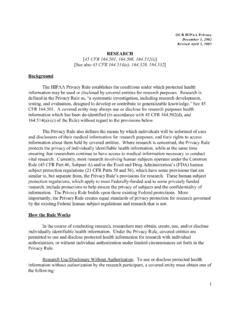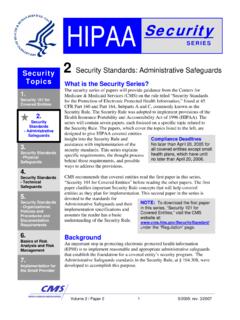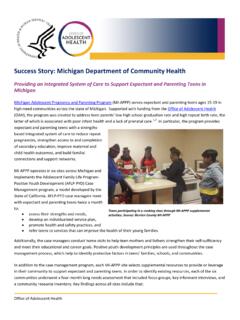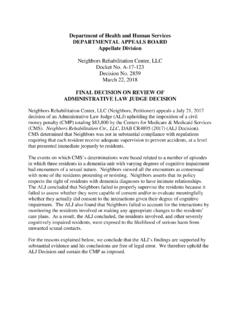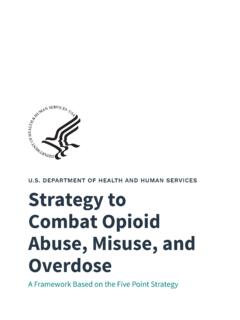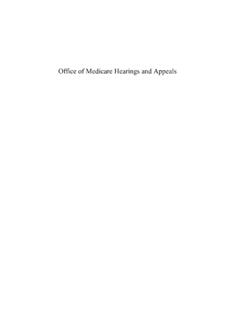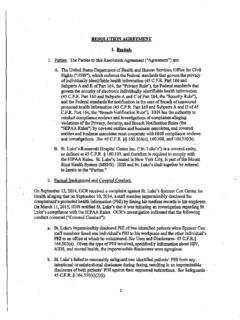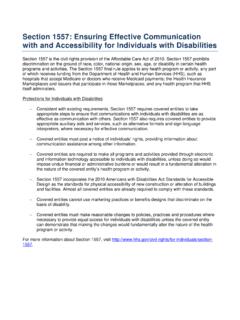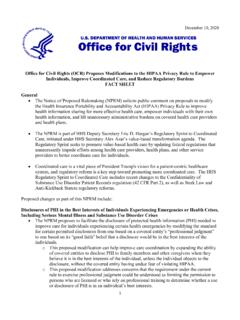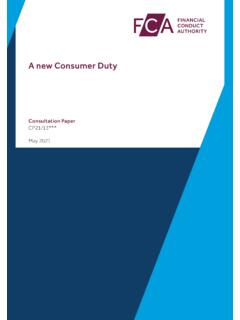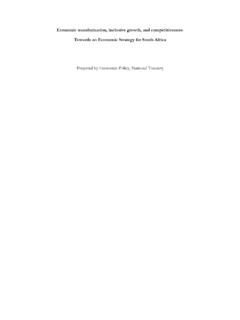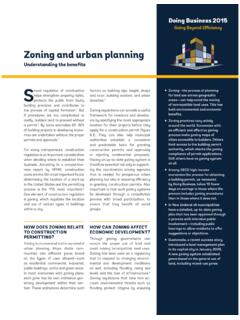Transcription of HHS Rural Action Plan
1 Rural Action plan US Department of Health and Human Services September 2020 Table of Contents Message from the Secretary .. 1 Executive Summary .. 3 Section I. Introduction .. 5 Section II. Setting the Rural Context .. 7 Section III. The Four-Point Strategy to Transform Rural Health and Human Services .. 16 Section IV. Upcoming Actions to Support Rural America .. 19 Strategy 1: Build a Sustainable Health and Human Services Model for Rural 19 Strategy 2: Leverage Technology and Innovation .. 24 Strategy 3: Focus on Preventing Disease and Mortality .. 28 Strategy 4: Increase Rural Access to Care .. 35 Section V. Highlighting Recent Rural Efforts .. 39 Strategy 1: Build a Sustainable Health and Human Services Model for Rural 39 Strategy 2: Leverage Technology and Innovation.
2 44 Strategy 3: Focus on Preventing Disease and Mortality .. 46 Strategy 4: Increase Rural Access to Care .. 54 Conclusion .. 59 Appendix A: Upcoming Actions to Support Rural America .. 60 Strategy 1: Build a Sustainable Health and Human Services Model for Rural 60 Strategy 2: Leverage Technology and Innovation .. 60 Strategy 3: Focus on Preventing Disease and Mortality .. 62 Strategy 4: Increase Rural Access to Care .. 64 Appendix B: Highlighting Recent Rural Efforts .. 65 Strategy 1: Build a Sustainable Health and Human Services Model for Rural 65 Strategy 2: Leverage Technology and Innovation .. 66 Strategy 3: Focus on Preventing Disease and Mortality .. 69 Strategy 4: Increase Rural Access to Care .. 74 Citations .. 75 Rural Action plan Page 1 Message from the Secretary One of the top priorities of the Trump Administration is enhancing the way we deliver health and human services in Rural areas.
3 There are 57 million residents in Rural America, spread across 80 percent of the country s landmass. Across these communities, Department of Health and Human Services (HHS) programs and resources play an important role, from providing preschool and childhood development services through Head Start to enhancing access to health care through Critical Access Hospitals (CAHs) or community health centers or ensuring that families achieve self-sufficiency through Temporary Assistance for Needy Families (TANF). In response, the HHS Rural Task Force developed this Rural Action plan as the next step for the Department to enhance its focus on Rural communities. We realize we cannot maintain the status quo approach for Rural America. That is why we developed the Secretary s Four-Point Strategy to Transform Rural Health and Human Services, which builds on current HHS initiatives in the following areas: Build a Sustainable Health Model for Rural Communities; Leverage Technology and Innovation; Focus on Preventing Disease and Mortality; and Increase Rural Access to Care.
4 Rural communities are places of great vitality and innovation, with a strong spirit of collaboration. They are key producers of the nation s food supply and play a central role in supporting energy production while serving as an integral part of the larger national economy. Rural areas face challenges in access to care, financial viability, and demographic and structural issues. Their residents tend to be older and in poorer health than urban counterparts. Rural residents are more likely to die from heart disease, cancer, unintentional injury, chronic lower respiratory disease, and stroke than their urban counterparts. The deep impact of the COVID-19 pandemic is nationwide, but particularly challenging for Rural communities given a limited health care infrastructure, fewer clinicians, and a host of other barriers.
5 As we continue to take the steps necessary to respond to this public health emergency it only reinforces how critical it is that Rural issues continue to be a priority for HHS. When you are selecting priorities as a leader, you do not pick particular challenges just because they are pressing problems though certainly that is a criterion. You also pick something as a priority because it requires more than just continuing business as usual it requires transformation. There is no better example of an area that needs this transformation than the delivery of Rural health and human services. We realize that one size does not fit all. There is a need to think differently about how HHS engages with Rural communities and how our programs and regulations can best meet the needs of Rural communities.
6 For that reason, in late 2018, I created a Rural Task Force at HHS, with key leaders and stakeholders from across the Department. The goal of the Task Force is to bring together disparate efforts across HHS and develop the best understanding of where policy and program changes can help bring about the needed transformation. Rural Action plan Page 2 So what have we been thinking about so far? Our goals for Rural health and human services are simple: they need to be affordable; they need to be accessible; they need to be high quality; they need to be sustainable; and they need to be innovative. The HHS Rural Action plan represents an important step in our work with Rural America. It includes key initiatives we have already taken to align with those goals. For example, we have expanded access to care in Rural communities by increasing the number of community health centers that serve Rural areas.
7 We have taken steps to help Rural providers make the transition to value-based care, with the goals of improving quality and reducing the growth of health care spending. HHS programs have helped address the opioid epidemic in Rural communities. Through changes to Medicare, we have also expanded access to telehealth services, allowing us to bridge the gaps in care in Rural communities. This has been particularly true in response to the COVID-19 pandemic as we made rule changes in Medicare that have allowed clinicians across the country to provide care virtually in response to the public health emergency. The HHS Rural Action plan builds on the momentum of these efforts and includes a variety of programs slated for implementation in Fiscal Year (FY) 2020. This report covers a variety of programs authorized by Congress and administered by HHS.
8 However, it is important to note that based on assessment of the effectiveness of some of these efforts, HHS does not include funding for some of these programs in the FY 2021 President s Budget request. HHS continues to evaluate the effectiveness of these programs as statutorily required. The President s FY 2021 Budget proposal also includes a focus on Rural health and human service transformation that range from key regulatory efforts to reduce burden and expand access as well as targeted Rural program investments in maternal health and enhancing access to Human Immunodeficiency Virus (HIV) care. All of this adds up to an unparalleled focus on Rural issues for HHS, which is only heightened by the emergence of COVID-19 and its impact on Rural communities. Meeting the needs of Rural communities relies on expanding our partnerships; and the HHS Rural Task Force will expand its collaboration with federal partners as well as its private-sector partners.
9 This combined effort will expand the breadth and reach of our impact on Rural communities. Alex M. Azar II Secretary, Department of Health and Human Services Rural Action plan Page 3 Executive Summary In 2018, Secretary Alex M. Azar II identified Rural health as a Department of Health and Human Services (HHS) priority. The Secretary created the HHS Rural Task Force to better understand the Department s current and planned efforts to strengthen HHS coordination to better meet the needs of the 57 million Americans who live in Rural communities. One of the outcomes of the work of the Rural Task Force is this Rural Action plan , which provides an initial framework and set of activities designed to meet those goals. Rural Americans face unique challenges in terms of access to health and human services.
10 Individuals in Rural areas tend to be older, with higher rates of chronic disease and lower life expectancy. As the nation s largest payer of health care services and funder of social services, HHS is in the position to address a range of factors that influence Rural health care outcomes and access to social services. The Rural Action plan provides a description of the current Rural health care and human services landscape, particularly the challenges Rural individuals and communities face in accessing and financing health care and human services. The characteristics of Rural health and human service disparities include poorer health status, with residents of Rural areas more likely than their urban counterparts to die from heart disease, cancer, unintentional injury, chronic lower respiratory disease, and stroke, and to have health care and human service workforce shortages, fragile provider networks, and the limited and varied capabilities of public health and human services departments, among others.
